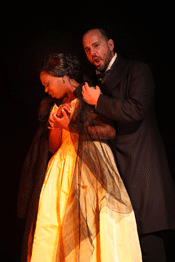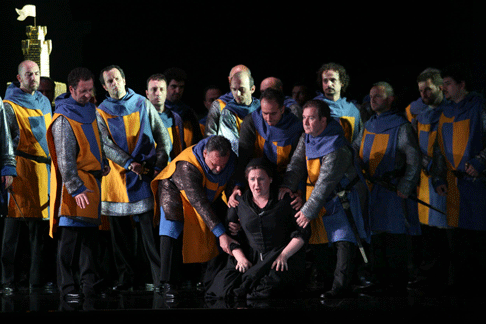Parma devotes the months to a major Festival, with other activities in
nearby towns. Parma’s Verdi Festival aims at producing, by 2013, a boxed
set of Teatro Regio DVDs with all Verdi’s operas in a special edition.
In Florence, the Teatro del Maggio Musicale Fiorentino produced “the
big three” — Rigoletto, Il Trovatore and La
Traviata — heard together on three successive nights. These were all
entirely new productions by a young team, specialists in low cost but
innovative work. This festival, a co-production with the elegant, classical
Teatro Romolo Valli will continue in Reggio Emilio, “Verdi
country”, but will not be heard in Parma.
 Scene from Il Trovatore
Scene from Il Trovatore
Prices were quite low by European standards. The house was sold out in the
first week of bookings, proceeds reaching € 600.000, about two thirds of
the cost. As comparison, ticket sales in Italian houses cover, on average,
about 12% of production costs. Nearly 25% of the audience was made up of young
people under 26. Usually, the average of the audience is around 55 in Italian
opera houses. For many of them, it was the first time they’d been in an
opera house so they looked enthralled.
Ripa di Meana and his team (Edoardo Sanchi, set design, Silvia Aymonimo
costumes, Guido Levi lighting). Guido Levi in charge of lighting.see the three
operas as a single piece of musical theatre in three parts, viz.
Rigoletto as a dark introduction in various shades of black and grey,
Il Trovatore as a fantastic tragedy in blue and red, and La
Traviata as a flowery dream.
This Rigoletto is “noir” rather than a dark
introduction to the cycle. The entire plot is played in a bleak night. Very
simple elements on the huge stage of the Teatro del Maggio Musicale:a movable
wall squeezing the protagonists in a deadly tie, an oversized period car (a
1940s Buick?) where the Duke consummates his orgies, a small white doll house
for Gilda, and old boat on the Mincio for the final scene. It is a tragedy
without any glimmer of hope, not even in Caro Nome, or in the Love Duet.
Stefano Ranzani’s baton and the Maggio Musicale Orchestra (one of the
very best orchestra in Italy for both opera and symphony ) were perfectly in
line with this reading of the opera. Ranzani emphasizes the C flat and the D
flat so that even the orchestra emanates a bleak color and atmosphere. Alberto
Gazale was an excellent Rigoletto both dramatically and vocally and had a
superb partner in DesirÈe Rancatore as Gilda; the opening night, (October 3rd),
at the audience’s request, they had to encore the final scene of the
second acts (“SË, Vendetta, Tremenda, Vendetta”). It was harder to
judge Gianluca Terranova who was called at the last moment to replace James
Valenti as the Duke. He is a generous tenor, with an excellent acute and a
strong volume, but uncertain phrasing — probably because he had to jump
in the role without any rehearsal.
The following night Il Trovatore was played to a full house. On
stage, there were no castles, no cloisters, no prisons, just a large early 20th
century elegant living rooms with blue walls and a shocking red pyre (when
required) or arches for the second act ‘s convent. However, the Count and
Manrico (and their retinues) are in Medieval armour, whilst Eleonora, Azucena
and the others in modern attire. The heightens the timeless reading of a plot
where only Azucena is the character with psychological development. The others
are stereotypes, almost a pretext for their arias, duets and concertatos. Some
of the audience did not appreciated this interpretation of Il
Trovatore, but at the end the applauses submerged the boos. Massimo
Zanetti offered a carefully discreet conducting — in Il
Trovatore the orchestra is mostly a support to the singers.
 Scene from Il Trovatore
Scene from Il Trovatore
Juan Jes˘s RodrÏguez, Anna Smirnova and Stuart Neill are well known serious,
experienced professionals. Stuart Neill gave a vibrant high C at the end of
“Di Quella Pira” without attempting to sustain it too long. The
real surprise was the young Arkansas soprano Kristin Lewis; a true soprano
assoluto with a very large extension, a pure emission, an excellent
coloratura and the skill to go up quite naturally to the highest
tonalities and go down, equally naturally, to the lowest. She lives in Vienna
and sings mostly in Europe. It is easy to foresee that she will go far.
La Traviata had a single set: a large Art Nouveau living room with
camellia flowers on the wall paper as well as in many vases and pots. Lighting
provides various shades of green and of white on the walls. An oversize sofa
dominates Violetta’s apartment in the first and third act; furnished in
turn of the century style. The dreamy atmosphere is already in the introduction
when Violetta is on stage longing for a bourgeois family life. But she really
lives a Baudelaire’s environment where we nearly smell opium.
Conductor Daniele Callegari slowed the tempos gently — the performance
lasts slightly longer than three hours, with two intermissions — in order
to gently heighten the dreamy atmosphere.
Andrea Rost proved that her vocal instrument is still perfect even though
quite a few years have elapsed since the seasons when she was the major star of
La Scala . Her singing was passionate; she did not circumvent any of the
traditional virtuoso, added (over the centuries) to Verdi’s original
writing such as the B flat at the end of “Sempre Libera”. Saimir
Pirgu is young (28 years old), and athletic. His Libiamo requires acrobatic
skills. He is good looking; and his voice has thickened in the last couple of
years. He is now a perfect Alfredo, especially for his tender phrasing. He
should resist the temptation to take on tenore spinto roles, but he would be
probably excellent in many Massenet and Gounod parts. Luca Salsi is a good
Giorgio Germont but maybe too young for the role. It is not clear whether
Saimir Pirgu’s Germont senior is just an old-fashioned Provincial country
gentlemen or a hypocrite. Nonetheless, on a Sunday matinee, the audience was
enthusiastic, applauding during the performance.
Giuseppe Pennisi
Production Staff and Cast
Franco Ripa di Meana, director. Edoardo Sanchi, sets. Silvia Aymonino,
costumes. Guido Levi, lighting. Orchestra e Chorus del Maggio Musicale
Fiorentino. Piero Monti, chorus master.
Rigoletto
Stefano Ranzani: conductor.
Gianluca Terranova:James Valenti; Shalva Mukeria: Il duca del Mantova;
Alberto Gazale: Rigoletto; DÈsirÈe Rancatore: Gilda; Konstantin Gorny:
Sparafucile; Chiara Fracasso: Maddalena; Giorgia Bertagni: Giovanna; Armando
Caforio: Il Conte di Monterone; Roberto Accurso: Il Cavaliere Marullo; Luca
Casalin: Matteo Borsa; Andrea Cortese: Il Conte di Ceprano; Miriam Artiaco: La
Contessa di Ceprano; Vito Luciano Roberti: Usciere di corte; Elisa Luppi: Un
paggio.
Il Trovatore
Massimo Zanetti: conductor.
Juan Jes˙s RodrÌguez: Il Conte di Luna; Kristin Lewis: Leonora; Anna
Smirnova: Azucena; Stuart Neill: Manrico; Rafal Siwek: Ferrando; Elena Borin:
Ines; Cristiano Olivieri: Ruiz; Alessandro Luongo: Un vecchio zingaro; Fabio
Bertella: Un messo.
La Traviata
Daniele Callegari: conductor.
Andrea Rost: Violetta ValÈry; Milena Josipovic: Flora Bervoix; Sabrina
Modena: Annina; Saimir Pirgu: Alfredo Germont; Luca Salsi: Giorgio Germont;
Aldo Orsolini: Gastone; Francesco Verna: Il Barone Douphol; Gabriele Ribis: Il
Marchese d’Obigny; Michele Bianchini: Il Dottor Grenvil; Leonardo Melani:
Giuseppe; Salvatore Massei: Un domestico; Pietro Simone: Un commissionario.
image=http://www.operatoday.com/RIGOLETTOmmf01.gif
image_description=Rigoletto at the Verdi Festival [Photo by Giuseppe Cabras/New Press Photo courtesy of Teatro del Maggio Musicale Fiorentino]
product=yes
product_title=Giuseppe Verdi: Rigoletto, Il Trovatore and La Traviata
product_by=Verdi Festival, Parma
product_id=Above: Rigoletto at the Verdi Festival
All photos by Giuseppe Cabras/New Press Photo courtesy of Teatro del Maggio Musicale Fiorentino